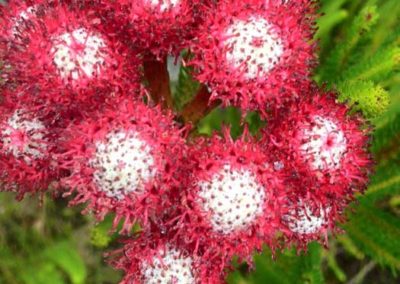Cape Mountain Ecology
If ecology is defined as being the study of the relationships between living organisms and their environment, then budding ecologists may despair on first sight of the Cape Fold Mountains.
Seen from the air, these element-battered mountains seem largely lifeless. Indeed, their sandstone-derived soils are among the most impoverished in the world. Closer up, a covering of grey-green vegetation meets the eye – the fynbos, soon to reveal itself as the world’s most diverse plant habitat and crammed to the brim with thousands and thousands of different plants.
And the shortest of walks will show you that far from empty of wildlife, the Cape mountains certainly have animals, admittedly not in huge numbers, but of amazing diversity and with high levels of endemism. The mountain environment is home to leopards and antelopes, its rivers host frogs and fish while eagles, ravens and sugarbirds rule the clean mountain air.
The geology of the mountains and their hinterland dictates the particular environment with its plants and animals. Renosterveld, for example, is a remnant grassy biome that favours clay soils derived from ancient shale; fynbos vegetation (with a completely different set of plants) prefers the sandy soils of the more recent sandstones. Find out about the Cape Mountain environment here.
The climate has an equally important effect on the mountain’s plants and animals. The amount of rainfall, shade and shelter from the wind has a profound effect on the environment that can easily be seen: hike up Table Mountain’s south-east facing slopes and you’ll be in thick indigenous forest or head-high fynbos. Hike up the north face of the same mountain and you won’t see a single tree and the fynbos is at your knees. Read more about the Cape climate here.
The plants are of course immediately obvious once you start walking in the mountains. Far from being a dull fuzz of greenery it seems from afar, the fynbos morphs into a dazzling treasure box of colour, sense and form: copper-tipped reeds and scented bushes compete with squat protea trees; green, orange and cream lichens carpet the rocks like faux camouflage. And everywhere flowers – red, blue, pink, white, yellow … every colour you can name. Learn more about the Cape flora here.
The wildlife isn’t so obvious – at first glance anyway. A tough climate, a regular fire regime and frugal, energy-saving plants mean slim pickings in the fynbos and animal numbers are low. But the list of mammals starts with leopards, antelope and baboons and works its way down to unusual flowering-pollinating rodents and secretive genets. There are reptiles and amphibians plus fascinating insects and of course birds. And although there aren’t many species of birds in the fynbos compared to other parts of South Africa, the ones you see tend to be brightly coloured endemics. Find out more about the Cape mountain fauna here.
Together it makes for an intricate, interwoven environment of plant and animal species. There are certain plants that require the services of a single insect pollinator for example. Other plants grow only on a single rocky ridge or couple of sodden mountain peaks. Plants have adapted to fire – some only flower after it – and so have animals. And despite generations of scrutiny, scientists are still making astonishing discoveries in these mountains. Who would have thought that a handful of wet mountain walls in the Western Cape could be home to an insect species unknown until 15 years ago – the Cliff Water Beetle (Aspidytes niobe), the closest relative of which lives in central China.











